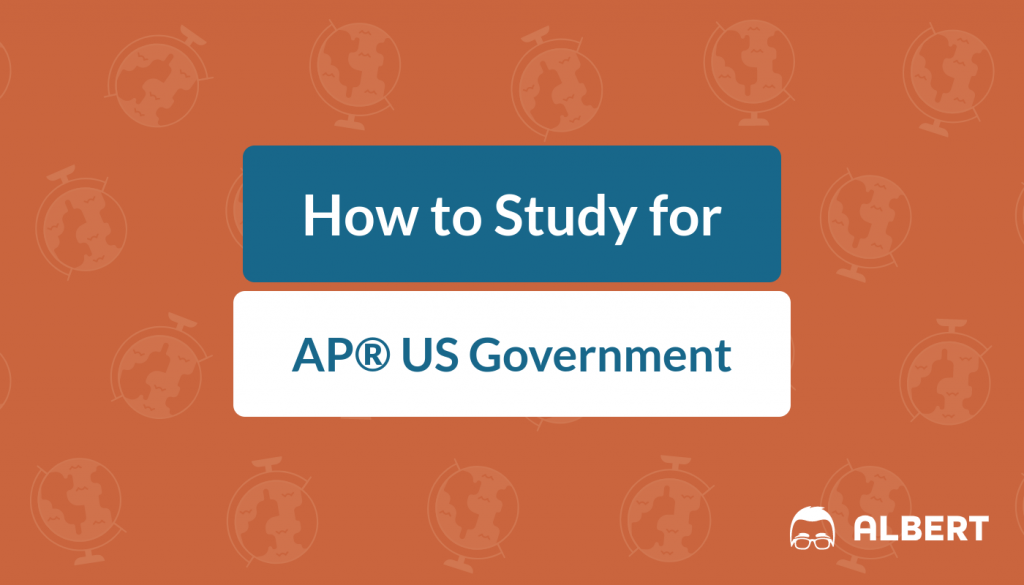In 2015, 280,000 students took the AP® US Government Exam. How did they do? While the encouraging news is that 48.1% of students passed with a 3 or higher, only 23.4% passed with a 4 or 5. The lack of success at the four and five level is somewhat remarkable since many consider the AP® US Government Exam to be one of the easier exams! One of the best AP® US Government tips is simple- you need to understand that the exam is broken down into two major sections (what to expect) and how to answer the questions in the Free Response Section (what to do). This AP® US Government study guide help you know what to expect and what to do when it comes to AP® US Government exam test time!
First Things First: Which Exam are You Taking?
Before starting off on your AP® US Government study plan, it’s important to make sure you are studying for and registering for the correct exam! There are two AP® Government exams. One is AP® US Government and Politics; the other is AP® Comparative Government and Politics. AP® Comparative Government and Politics is far less commonly taken, with only about 20,000 students sitting for the exam in 2015.
This study guide is for AP® US Government. The AP® Course United States Government Description states that its purpose is to “give students an analytical perspective on government and politics in the United States and includes both the study of general concepts used to interpret the U.S. Government and various institutions, groups, beliefs, and ideas that constitute U.S. government and politics.” Be sure that you are studying and registering for the correct course before you go any further!
Is the AP® US Government Course updated, like some of the other AP® social studies and history courses?
The AP® US Government Course and Exam are currently under review but has not changed. If the College Board decides to give a new AP® US Government Exam, it will not be administered for the first time until 2019. This timing is great news for students looking for an AP® US Government study plan since they will be able to use all of the released questions from past exams with confidence.
What are the Course Objectives for the AP® US Government Exam?
To be prepared for the AP® US Government Exam, your course of study should prepare you to:
- describe and compare important facts, concepts, and theories pertaining to U.S. government and politics
- explain typical patterns and processes and behavior and their consequences (including the components of political behavior, the principles used to explain or justify various government structures and procedures, and the political effects of these structures and procedures)
- interpret basic data relevant to U.S. government and politics (including data presented in charts, tables, and other formats)
- critically analyze relevant theories and concepts, apply them appropriately, and develop their connections across the curriculum
Listed above are the objectives of the AP® US Government and Politics study course. This list, however, is pretty general.
But Are There Specific Topics I need to Know for the Exam?
Thankfully, the College Board provides a breakdown of the course topics, as well as how heavily weighted you can expect the exam to be in the six areas of study required:
- Constitutional Underpinnings of United States Government (5%–15%)
- Political Beliefs and Behaviors (10%-20%)
- Political Parties, Interest Groups, and Mass Media (10%-20%)
- Institutions of National Government: The Congress, the Presidency, the Bureaucracy, and the Federal Courts (35%-45%)
- Public Policy (5%-15%)
- Civil Rights and Civil Liberties (5%-15%)
As you can see, the topic on the exam that gets the most coverage is topic 4, the three branches of government. If your course has not emphasized Institutions, delayed it until the last minute, or you feel under-prepared on this topic, start here!
Though the six periods are not given equal coverage on the AP® US Government exam, it’s important to study for all of them. Not only will you be tested on each topic in both the multiple choice and free response portions of the exam, but you will also be expected to synthesize your knowledge from several topics to craft answers to particular questions.
As we continued in the AP® US Government study plan, you will get AP® US Government study tips for each topic covered by the exam and begin to grow comfortable with the test’s expectations.
AP® US Government Exam Format
If you have previously taken AP® exams in the areas like World History, European History, or US History, be prepared for change! The AP® US Government exam is quite a bit different from these history exams. The difference makes the exam easier to prep for in some ways, but tougher in others. There are only two sections of the AP® US Government Exam.
Section 1: Multiple Choice
In this portion of the exam, you will answer 60 multiple choice questions in 45 minutes. Some of these questions might include a stimulus, such as a map, graph, or chart, but unlike the new AP® history exams, many of the questions will not include a stimulus at all! You cannot rely on your ability to interpret stimuli well to get you through the multiple choice portion, but must bring to the table a significant knowledge base in all six topics to arrive at correct answers.
Section 2: Free Response Questions
In this part of the exam, you will answer 4 Free Response Questions in 100 minutes. Unlike other AP® exams, the AP® US Government Exam does NOT allow students any choice in which questions they will answer in free response. Each student is required to answer all four questions.
These questions will often have a prompt, worded as a declarative statement and sometimes include a map, graph, chart, or another stimulus that you need to be able to interpret to answer the question fully and accurately. The College Board lets students know that AP® free response questions will usually use one of the following “task verbs” in stating the question:
- Identify: provide a specific answer, which does not require causal explanation
- Define: provide a specific meaning for a word or concept
- Describe: provide the essential details or characteristics of a particular concept or political phenomenon
- Explain: demonstrate understanding of how or why a relationship exists by clearly articulating the logical connection or causal pattern between or among various political phenomena
- Compare: provide an explicit statement which connects two or more concepts
The free response section on the AP® US Government exam will include four questions that cover as wide of a range of material as possible. After a prompt, you will be asked to provide factual responses to the query posed, but also specific examples of the concept or phenomenon featured in the question. Below, we’ll look at some samples of past AP® US Government free response questions so that you can see what we mean.
How Are the Two Sections of the Exam Weighted?
Both sections of the exam are weighted equally, with the multiple-choice section at 50% of your exam grade and the free-response also at 50%. The good news is that while you are preparing for one section, you will learn what you need to know for the other.
Though it may sound corny, the ultimate AP® US Government tip is to be a serious student of AP® US Government. Knowing what you are talking about will help you not only in the area of content but in your confidence level. Take the time to prepare well and you can exit the exam room feeling like you have mastered the test, rather than it mastering you! Using this AP® US Government study plan is a sign that you are already on the right path for that result, so keep reading!
Succeeding on the AP® US Government Exam with the Concept Outline
The concept outline for AP® US Government is what your teacher should be following in selecting content to meet the objectives for your AP® US Government course. All AP® US Government instructors are required to submit a syllabus to the College Board that shows how their instruction will meet the requirements for presenting the objectives listed in the concept outline. Use the concept outline, which lists more specific content items to check up on your familiarity with the information you will need to know for the exam.
Topic Tips: Constitutional Underpinnings of United States Government
Prepare for questions on the US Constitution’s history and form, as well as on the type of government that the framers created. Constitutional Underpinnings includes understanding the framer’s unique ideas about democracy and the separation of powers, and one of the traditionally weak areas for students, federalism, so be sure you review it well. Here is a good source to study the concept of federalism.
Political Scientists put forth theories that are also important to know. Questions like “Who wields power in a democracy?” and “How the Constitution might be reformed?” are also possible topics that might appear as a multiple choice or free response question.
Let’s look at a few questions that have appeared on past exams or in the sample exam questions regarding the topic of Constitutional Underpinnings:
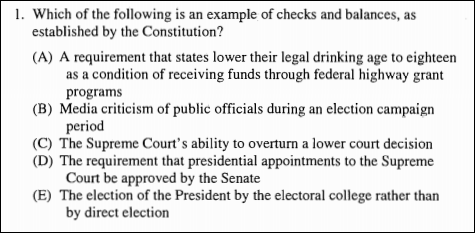
Notice that all of the answers represent something legitimate and recognizable in terms of the operation of the U.S. government. Only a student who has properly understood that the concepts of checks and balances, the Framers’ attempt to make sure that one branch of government would not become too powerful and overwhelm another, would realize that answer D is correct. Did you catch a reply that is a clear example of federalism?
Now, let’s look at a free response question from the 2013 exam:
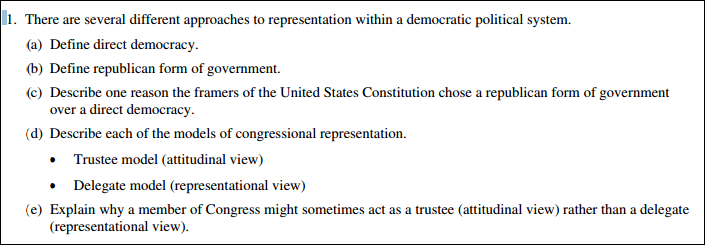
You can see multiple topics from the concept outline are covered by just this one question, including theories of democracy.
Topic Tips: Political Beliefs and Behaviors
The College Board has stated in the past that most students score well on questions that fall under this topic. You will be asked questions about how and where people form their political beliefs as well as how they form opinions and how this is reflected in their voting behavior.
Let’s compare two multiple choice questions on political beliefs and behaviors.
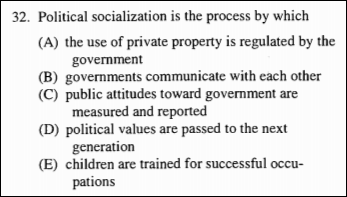
Obviously, this first question is an example of simple recall, as we discussed above. If you answered D, you are correct. The next question requires more analysis:
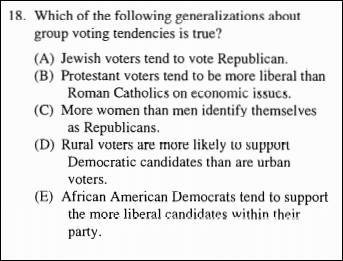
As the question states, the above requires you to understand generalizations. No one is saying that these hold true at all times, and it may be that these generalizations are becoming less accurate over time. The correct answer to the question is E.
Though a free response question may include elements of political belief and behavior, there has not been a free response question that concentrates on this area for at least ten years.
Topic Tips: Political Parties, Interest Groups, and Mass Media
This topic covers parties, including their typical platforms as well as their function and organization, the role of interest groups in influencing public policy (especially regarding PACs and Super Pacs), and the role of the media in influencing government and elections.
The 2016 exam featured a question that tested all of the elements of this topic and served as an example of how the College Board crafts AP® US Government FRQs to be wide-ranging:

To answer this question, you would need a thorough review of political parties and their role in elections, the role of the media and interest groups, and reach back to a previous topic, how interest groups might be said to limit representative democracy.
Topic Tips: Institutions of National Government: The Congress, the Presidency, the Bureaucracy, and the Federal Courts
Get prepared for questions on all three branches of the U.S. Government, including the often overlooked bureaucracy, which is a part of the executive branch.
Remember that the executive branch is the largest of the three branches! It is important to recognize that though the President is the chief executive, he uses his advisors, his staff, executive agencies, and the rest of the federal bureaucracy to carry out the laws that the Congress legislates.
Let’s look at a released Multiple-choice question on each of the institutions:
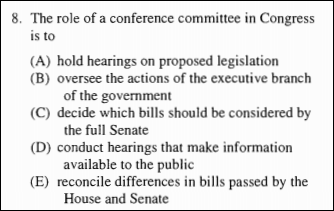
This question requires you to understand the structure of Congress and understand the process of how a bill becomes law, an important part of your AP® Government study plan! If you answered E, you are correct.
Next up, a recall question on presidential powers:
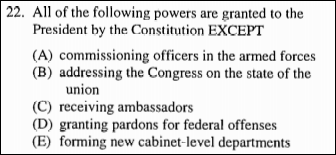
E was the correct answer, but in the year this question was included on the exam only 55% of test-takers got it correct!
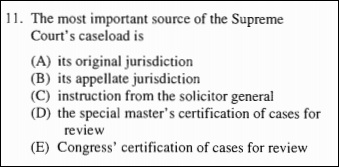
This question requires the student to understand the jurisdiction of the Supreme Court, or the types of cases it typically hears. The correct answer is B, since almost all of the cases that the U.S. Supreme Court hears are on appeal from the federal district and appellate courts.
To wrap up this topic, let’s look at a question on the bureaucracy:
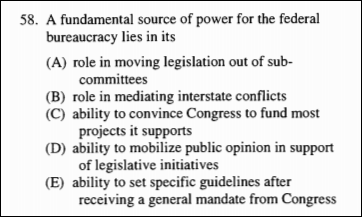
If you properly understand the bureaucracy’s role as executor of law and policy, you will have chosen E as the correct answer. Again, while only 335 of the students knew this answer, of those who scored a five on the exam the number was 73%. Preparation on this, the largest of the AP® US Government topics, makes a huge difference!
Before we move on, take a quick look at this 2014 question that requires knowledge of multiple branches of government, the Congress, and the Presidency:

Topic Tips: Public Policy
How should you prepare for this, the topic in the AP® course outline with the least weight? First, don’t assume that you won’t get a question in this area. The 2016 exam featured this question on public policy as one of the four required FRQs!
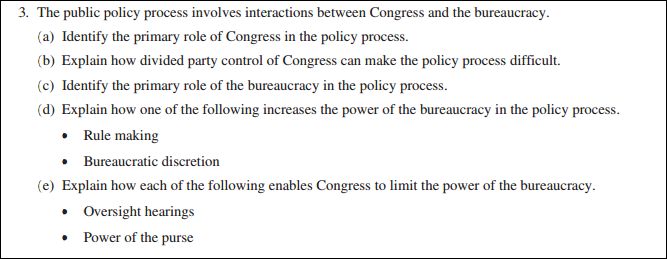
There are different theories as to how best to prepare for the public policy section. First, it’s important to know what public policy is! The AP® course description advises students to be familiar with “the formation of policy agendas, the enactment of public policies by Congress and the President, and the implementation and interpretation of policy by the bureaucracies and the court.”
Notice how all of the branches of government are involved. This inter-connectedness is why it may be best to study public policy as you prepare for other sections of the exam. As you look at specific issues and current events in your class or AP® US Government study plan, note how those issues are playing out in a public policy context.
Public policy is never found in isolation. In analyzing the question above, you’ll notice that the question requires knowledge of two things we covered in institutions: Congress and the Bureaucracy. Think of public policy not so much as a stand-alone topic, but in its relations (linkages) to the other topics on the exam. If you feel unsure of your knowledge of public policy, here is a list of public policy vocabulary terms you should feel comfortable with using or encountering on the exam.
Topic Tips: Civil Rights and Civil Liberties
This topic covers the rights of all citizens and emphasizes the struggle and recognition of those rights by specific groups such as women and minorities. Questions on this topic will often involve your knowledge of certain landmark Supreme Court cases. Hopefully, your course has encouraged you to learn and even memorize certain of these cases so that you can apply the principles that emerged from the decisions that were handed down by the court to an understanding of civil rights and civil liberties. Here is a list that may help you get started. It is also important for students to understand the role of the 14th amendment in expanding civil rights.
Below are some examples of questions, both multiple-choice and free-response that fall under this topic:
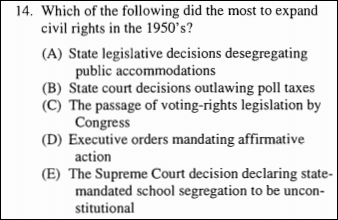
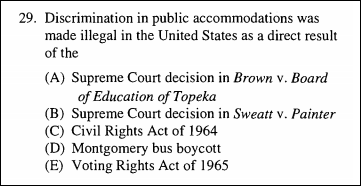
While the first multiple choice question asks about the general topics of civil rights, the second question requires the knowledge of specific landmark cases and legislation to arrive at the correct answer. (Answers: E, C)
Finally, this FRQ from the 2015 exam:
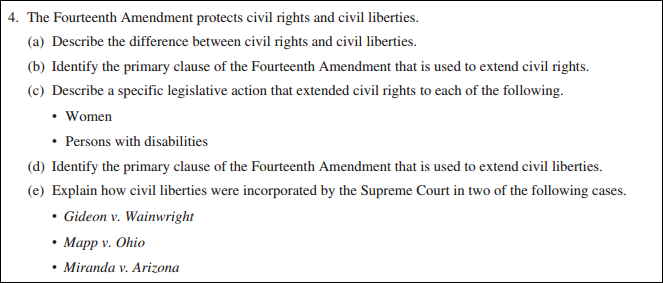
The College Board provides sample student answers to this question, along with scoring commentary that discusses how students did on this particular question in 2015. Take a look at the links provided to see how you would fare! Students in 2015 received an average of only 2.42 points out of the possible seven on this question. If you are willing to learn from their mistakes with the material the College Board provides, you’ll have a chance of being one of the elite 10% that scores a 5!
An AP® US Government Study Plan: Gathering Your Resources
As you prepare for your AP® US Government Review, you will benefit from gathering resources that are specifically targeted to help you succeed. Some students attempt to re-read the entire text for the course, along with reviewing their class notes. While this can work, it is likely not the most efficient use of your time, energy, and efforts —especially as the exam draws near! Instead, consider the following resources as potential help:
- The AP® US Government Course Description A 27 page guide to the AP® US Government exam, referenced throughout this article provides students with a full concept outline and exam description. The course description offers 25 sample multiple-choice questions and answers as well as four sample free response questions.
- The AP® US Government Released Exam, 1999. This is an actual exam released in 1999. These are very helpful for practicing multiple choice questions as well as for seeing the scope material that might be covered by the four free response questions.
- AP® US Government Sample Questions. The College Board’s course home page lists every free response question since 2003 on this page! Not only can you see past questions, but you can click on scoring guidelines to see how your answers would be scored by graders using the AP® rubrics. Look at actual student sample answers and how they were scored to help you avoid pitfalls and see helpful examples.
- AP® US Government Review Books. Most books offer multiple practice tests, but see if you can find one that offers an explanation of multiple choice answers, not only why an answer is a right answer, but one that explains why wrong answers are incorrect. You’ll be surprised at how helpful this is in cementing not only the concept that the question covers, but in helping you straighten out your thinking can recall when you make an error. An AP® book with a large glossary of terms can also be helpful in checking your understanding of AP® Government topics.
- Topical reviews of AP® US Government topics must be part of your AP® US Government study plan. Whether you physically missed class time, mentally checked out for a day or two, or are just having trouble recalling the details about a particular topic, AP® review books, videos, and review websites can offer a quick way to review the need-to-know details about particular period or event. Albert Blog offers review posts on its AP® US Government blog on everything from the political socialization to Political Action Committees with new topics added regularly!
Managing Your Time on the AP® US Government Exam
At only 2 hours 25 minutes, the AP® Government exam will go by in a flash. Making sure you are prepared about how to manage time will help you avoid time wastage, or becoming overwhelmed and flustered. Remember, the times break down like this:
- Multiple Choice: 60 questions/45 minutes
- Free response questions: 4 questions/100 minutes
Section I of the test includes the multiple choice questions, which the College Board designs to “assess your understanding of major course concepts, policies, and institutions, and to see how you apply skills of comparison and interpretation.” There are questions on the test that might be described purely as “factual recall”. Be ready!
Section II is an uninterrupted 100 minutes period. You will not be stopped during this time and told to move on to the next essay, so it is important that you pay attention to the clock. It is recommended that you spend about 25 minutes on each essay. Remember, on the AP® Government exam you are being asked to complete a series of specific tasks. Once you have done that adequately, move on to the next question! If you end up with extra time, you can always return to a previous FRQ and flesh it out with more detail or refine your answers.
Think about it: If you spend even five extra minutes on the first three questions in the free response section, you are left with only ten minutes total for the last question! Instead, look through each question quickly and begin answering as directed. Do not spend your time on the AP® Government exam formulating flowery or “attention-getting” introductory paragraphs!
Another tip for time management involves how to approach multiple-choice and free response questions that include a graph or chart. These types of questions can be huge time-wasters if not approached properly. You can end up using a lot of time in additional analysis if you don’t scan the entire question first. Let’s use an example from the course description to illustrate this time management tip:
Consider the chart and the multiple-choice question that follows:

You could spend several minutes digesting the available information in chart above. But with less than one minute per question on the multiple choice section, you will not have the time to do so.
Instead quickly read the title of the chart and recognize what it is all about —that in this hypothetical government, the President is a Republican, the Senate is controlled by Democrats, and the House by Republicans. Resist the temptation to analyze more right now! Instead, go immediately to the question and answer choices.
A student following this advice on the exam would find out that what he or she needed to know from the graph was simply that government is divided. Students just need to recognize that the information given indicates that different parties control various aspects of government, with close margins in the houses of Congress. Though this will not always be true, spending significant minutes on analyzing this stimulus is a waste of time. It is better to find out what the question is asking and then go back and do the analysis to the extent necessary for these types of questions.
This advice also holds true for political cartoons, which intimidate many students. First, ask yourself what the cartoon appears to be advocating, mocking, etc. Then move to the question to see what it is the exam is asking of you.
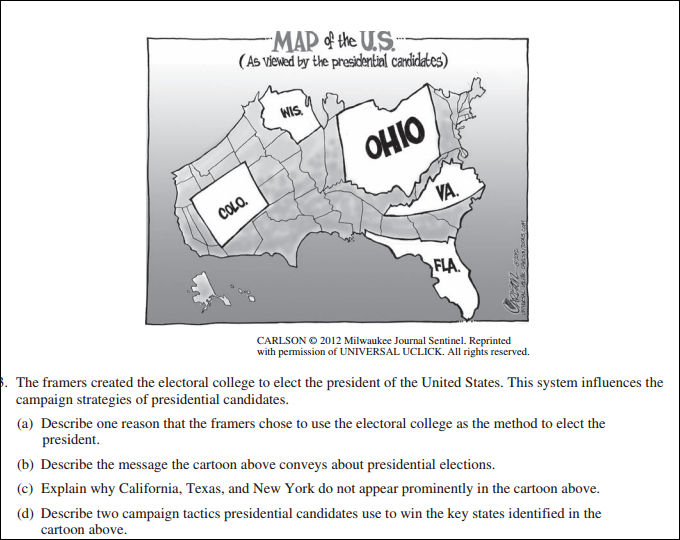
Here, you need only understand the idea that four states overwhelm the others in a Presidential race. From there, simply begin to answer the four parts the question requires.
Parting Advice: Keep Current!
Here is a final AP® US Government tip: Keep up with current events. Though the exam will not pose questions directly about issues in the news, you will frequently be asked to cite examples of how a principle or phenomenon can be seen in your free response essay answers. One AP® teacher recommends spending 15 minutes a day getting caught up on the headlines. One way to practice applying current events is looking for AP® Government review questions that require you to incorporate current events into your responses.
Looking for AP® US Government practice?
Kickstart your AP® US Government prep with Albert. Start your AP® exam prep today.

